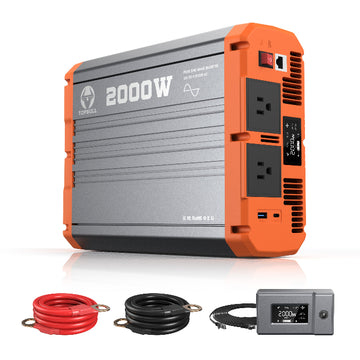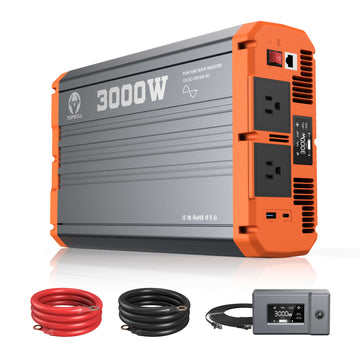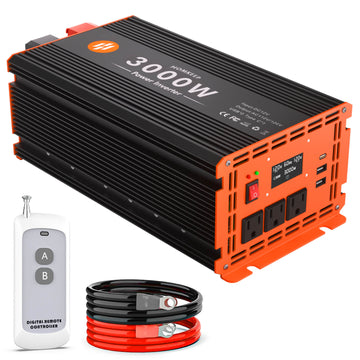A 12-volt DC power inverter is an essential device for converting 12V direct current (DC) from a battery into 120V alternating current (AC), allowing you to power standard household appliances on the go. Whether you need to charge a laptop in your car, run a small refrigerator while camping, or keep essential devices powered during an outage, a 12V DC power inverter is the solution.
This guide will explain how these inverters work, their applications, key considerations, and how to choose the right one for your needs. Read on to get started!
What is a 12 Volt DC Power Inverter
In many off-grid or mobile power scenarios, standard household appliances require AC (alternating current) power, but most batteries and vehicle power systems provide DC (direct current) power at 12 volts. This is where a power inverter comes in.
Definition and Working Principle
A 12V DC power inverter is a device that converts low-voltage direct current (DC) power from a 12V battery (such as a car battery or deep-cycle battery) into 120V alternating current (AC) power, making it suitable for household appliances and electronic devices.
This power conversion is achieved through an electronic switching process that mimics AC power. The inverter rapidly switches the DC input on and off to create a waveform, which is then stepped up by a transformer to match the voltage needed by standard appliances.
More Info:
12V to 120V Inverter: How It Works & What You Need to Know
Main Components of a 12 Volt DC Power Inverter
To ensure reliable power conversion, a 12V inverter consists of several key components:
-
Transformer – Increases the voltage from 12V DC to 120V AC (or 230V AC for European models).
-
Switching Circuit – Uses MOSFETs or transistors to generate an AC-like waveform.
-
Control Board – Regulates voltage and frequency, ensuring stable and efficient power output.
-
Cooling System – Includes heat sinks and fans to dissipate heat and prevent overheating.
-
Output Sockets – Provides AC outlets for connecting electrical devices.
- Safety Features – Built-in overload protection, short-circuit protection, and low-voltage alarms to prevent damage to connected equipment.
12 Volt Inverter Applications and What It Can Run
Whether you're on the road, enjoying the outdoors, or facing a power outage, a 12V inverter can keep essential devices running. Below are some of the most common uses and the recommended power ranges for each scenario.
1. Vehicle Applications (12V Car Inverter)
A 12V car power inverter is a must-have for road trips, mobile workstations, and emergency preparedness. It allows drivers and passengers to charge and use electronic devices directly from the vehicle's battery or cigarette lighter port.
-
Devices Powered: Laptops, smartphones, car refrigerators, small power tools, portable gaming consoles.
- Recommended Power Range: 300W - 1000W inverters, depending on the total power consumption of connected devices.
2. Camping and Outdoor Use
For camping, RV trips, and off-grid adventures, a 12V inverter provides reliable power for essential devices, ensuring convenience and comfort in remote locations.
-
Devices Powered: Camping lights, portable fans, electric kettles, small induction cooktops, and rechargeable battery packs.
- Recommended Power Range: 500W - 1500W inverters, based on the wattage of connected appliances.
3. Home Emergency Backup Power
During power outages, you can use inverters as emergency home backup power for essential household appliances, offering peace of mind until grid power is restored.
-
Devices Powered: WiFi routers, televisions, fans, CPAP machines, LED lights, and small refrigerators.
- Recommended Power Range: 1000W - 2000W inverters, depending on the total power draw of essential devices.
By choosing the right 12V inverter for your specific needs, you can enjoy uninterrupted power for travel, outdoor activities, and emergencies.
Key Considerations When Using 12-Volt DC Power Inverters
When using a 12V DC power inverter, it's essential to understand several key factors to ensure optimal performance and avoid damage to both your inverter and connected devices. Here are some important considerations before you get started.
Calculate Total Power Consumption
One of the first steps before selecting a 12V inverter is calculating the total power consumption of the devices you plan to run. To ensure the inverter can handle the load, you'll need to add up the wattage of each appliance you'll use simultaneously.
-
Why it matters: If the combined wattage exceeds the inverter's rated power, it could overheat or malfunction. Always choose an inverter with a power rating higher than the sum of your devices' wattage.
- Tip: Look for the "wattage" label on each device or check the manufacturer's specifications to determine their power consumption.
Consider Startup Power
Many appliances, particularly motors and compressors, require more power when they start up, which is called surge power or peak power. This is especially true for appliances like refrigerators, air conditioners, and power tools.
-
Why it matters: If your inverter can't handle surge power, it could fail to start the appliance or trip the safety features.
- Tip: Ensure the 12V inverter you choose can handle higher surge power. For example, a refrigerator might require 3x its running wattage during startup, so choose an inverter that can accommodate this peak demand.
Battery Capacity and Runtime
The battery capacity plays a crucial role in how long your 12V inverter can run appliances before needing a recharge. Deep-cycle batteries, which are designed to be discharged and recharged regularly, are the best choice for inverters.
Why it matters: Battery capacity, measured in ampere-hours (Ah), determines how much power your battery can provide and for how long. The larger the battery capacity, the longer your devices will run.
How to calculate runtime: Use the following formula to estimate how long your battery will power your devices:
- Battery Capacity (Ah) × 12V × Efficiency (%) / Load (W) = Runtime (hours)
- Example: A 100Ah battery with 90% efficiency and a 500W load will run for approximately 9.6 hours (100 × 12 × 0.9 / 500).
How to Choose the Best 12-Volt DC Power Inverter
When choosing a 12V DC power inverter, it's important to consider your power needs and the type of device you'll be powering. The right inverter ensures you get the most reliable performance and avoids damage to your appliances. Below are key factors to consider when making your selection.
Pure Sine Wave vs. Modified Sine Wave Inverters
Inverters come in two primary types: pure sine wave and modified sine wave. The type you choose will depend on the sensitivity of your devices and the quality of power they require.
-
Pure Sine Wave Inverter: This inverter provides a clean, stable, and smooth flow of AC power, making it ideal for sensitive electronics like laptops, medical devices, audio equipment, and high-end appliances. It closely mimics the power supplied by utility companies, ensuring no interference or damage to your devices.
- Modified Sine Wave Inverter: While suitable for basic appliances like lights, small tools, and fans, a modified sine wave inverter may cause interference in sensitive electronics. This could result in operational issues or a reduced lifespan for devices like computers, microwaves, and TVs.
When it comes to sensitive devices, always opt for a pure sine wave inverter to ensure optimal performance and safety.
Best Choice: Topbull's 12-Volt DC Power Inverters
For reliability and performance, Topbull 12V power inverters are highly recommended. Known for their robust design and superior efficiency, Topbull's inverters provide stable power for a wide range of applications. Here are three excellent options.
-
2000W Pure Sine Wave Inverter: Ideal for home emergency power, powering TVs, WiFi routers, refrigerators, and kitchen appliances. It's compact, efficient, and perfect for moderate power needs.
-
3000W Pure Sine Wave Inverter: Best suited for camping, RVs, and outdoor use, this inverter can easily run induction cooktops, coffee makers, and other mid-power appliances while on the go.
- 4000W Pure Sine Wave Inverter: Perfect for high-power applications, such as microwaves, large refrigerators, and power tools. This inverter is a reliable choice for heavy-duty needs and larger setups.

By choosing Topbull's 12V DC power inverters, you can ensure long-lasting and safe operation of your devices, regardless of the power requirements.
FAQs About 12 Volt DC Power Inverters
Can a 2000-Watt 12-Volt Inverter Run an Air Conditioner?
Typically, no. Most air conditioners require a minimum of a 4000W inverter to handle both the startup surge and continuous running power. Air conditioners demand a large amount of energy, especially during startup, so a higher wattage inverter is necessary for smooth operation.
Will a 12 Volt Inverter Overheat with Prolonged Use?
Yes, overheating can occur if the inverter is running at or near its full capacity for extended periods. To prevent this, always ensure proper ventilation around the inverter and choose a model with an integrated cooling system, such as fans or heat sinks, to help dissipate heat effectively and maintain safe operation.
Can a 12 Volt DC Power Inverter Be Used in an RV or Solar Power System?
Yes, 12V inverters are commonly used in RVs and solar power systems. When choosing an inverter for these setups, ensure that it is compatible with your battery bank and solar panel capacity. This ensures your system runs efficiently and can handle the load of various devices without issues.
Conclusion
A 12V DC power inverter is essential for converting battery power into AC electricity, providing reliable power for vehicles, outdoor activities, or home emergencies. When choosing an inverter, consider power requirements, surge capacity, and battery runtime. Topbull pure sine power inverters offer excellent reliability and safety, ensuring uninterrupted power wherever you need it. Make the smart choice for your inverter needs!













